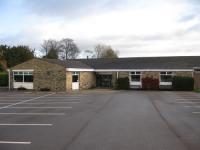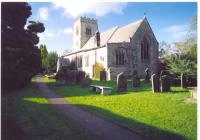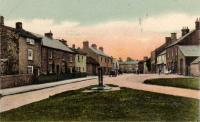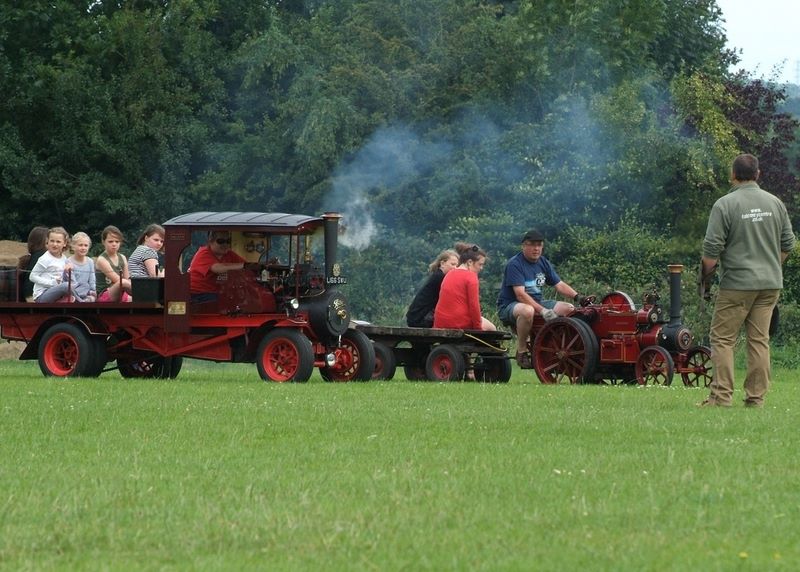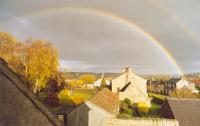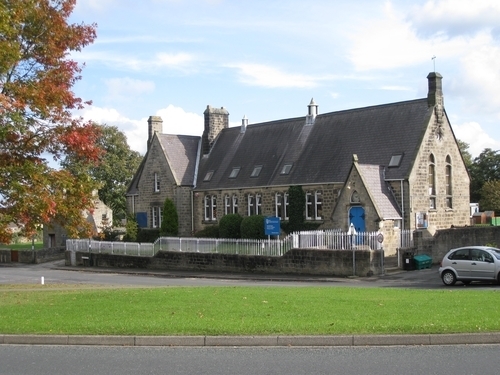Recent articles
© DT Online 2010 - 2025
| Manor Farm HouseIn this present-day photograph it is possible to discern the farming origins of the buildings now called The Manor Farm House. The left hand portion is clearly a conversion of a former barn. An old aerial photograph makes the former history and use very clear. (click photo to enlarge) The house is one of Hampsthwaite's Grade II listed structures and is described thus . . . . . "House. Early C19. Coursed squared gritstone, grey slate roof. 2 storeys, 2 bays. Quoins. Half-glazed 4-panel door to right of centre in gabled porch; 4-pane sashes in plain stone surrounds with projecting sills throughout. Shaped kneelers, gable copings, end corniced stacks. Included for group value." That last sentence reveals the listing to be justified by the house's contribution to the group of buildings amongst which it stands. Writing in 1871, William Grainge ("Harrogate and the Forest of Knaresborough") says . . . . . "In the field called the Hall Garth, adjoining the village on the west, are traces as if some important building had formerly stood there. The name also is suggestive of some such erection. The farm to which it belongs is sometimes called the Manor Farm; it is of freehold tenure, and was purchased by the late Mr. B.J.Wilson from C.H.Elsley, Esq., late Recorder of York. These lands at one time belonged to the Priory of St. Robert's of Knaresborough. In 1869, this farm was purchased by William Sheepshanks, Esq., of Leeds and Harrogate, the present owner." The Ordnance Survey Map of 1891 shows the farmhouse and its outbuildings under the name "Manor House Farm" but the 1853 map calls it "Hall Garth Farm". Given its proximity to the parish church and to the adjacent parsonage there can be little doubt about the farmland's early ownership by St. Robert's Priory but Grainge's statement about ownership at the time he was writing may not be quite accurate. According to the records at the West Riding Deeds Registry a substantial amount of land in Hampsthwaite had been awarded in the 1770s on the Inclosure of the Forest of Knaresborough to the Reverend Gregory Elsley. His successor, the Reverend Heneage Elsley was party in 1829 to a Lease and Release with Bilton Josephus Wilson (see the entry for Thimbleby House in Church Lane) and one Mathew Thackray - that deed specifically described the Manor Farmhouse and its outbuildings and fields in these terms . . . . . "the Manor or reputed manor of Hampsthwaite in the County of York and all that messuage or farmhouse called the Manor House with the outbuildings, foldyard (?), gardens and stackyard thereto belonging and containing by admeasurement with the sites of the buildings two roods and twenty seven perches And also all those several closes or parcels of arable meadow and pasture land adjoining the said messuage and premises called by the several names and containing by admeasurement the respective quantities hereinafter mentioned be the same or any of them more or less or otherwise called or known that is to say Well Garth two roods and nine perches Church Croft seven acres two roods and seven perches the new High Pasture and Thirstly Field now in one close fourteen acres one rood and nine perches The Brackenbridge Wood or Plantation four acres and thirty three perches the Calf House Hill and Far High Pasture now in one close called the Horse Pasture adjoining Tang Beck ten acres three roods and seventeen perches Hebden Pasture five acres one rood six perches the Far White Field five acres thirty five perches the near White Field six acres two roods and twenty seven perches Long Aynham six acres and twenty eight perches Broke Bank six acres and thirty three perches the Great Close ten acres three roods and twenty five perches and the High Close seven acres one rood and thirty five perches.." It has to be surmised that this deed was that under which Bilton Wilson acquired the land and when the next transaction appears in the records on 6th April 1870 involving an apparent disposal of this and other property to the Reverend Thomas Sheepshanks by the Reverend John Grisedale, Thomas Sanders and William Pollock that those three gentlemen were the executors of the will of Bilton Wilson who had died in 1866. On the 8th November 1922 the farmhouse and its lands were conveyed by William Sheepshanks (son of Thomas who, presumably, had died in the meantime) to Frederick Alfred Aykroyd of Birstwith Hall. The deed gives a good description of the extent of the property which is said to include enclosures (as numbered on the 1909 Map) 326/322/280/282/283/284/286/279 (and 270 then in one)/281/264/260/285/259 (allotments) 269/265/263/262/ and 267 all of which were also delineated on the plan annexed to the conveyance. On the 8th October 1936 Sir (as he then was) Frederick conveyed the property (and substantial other property) to the Tang Estates. Here are two old views of the farmhouse taken from early postcards. (click photo to enlarge) Click here for extracts from early census returns |









